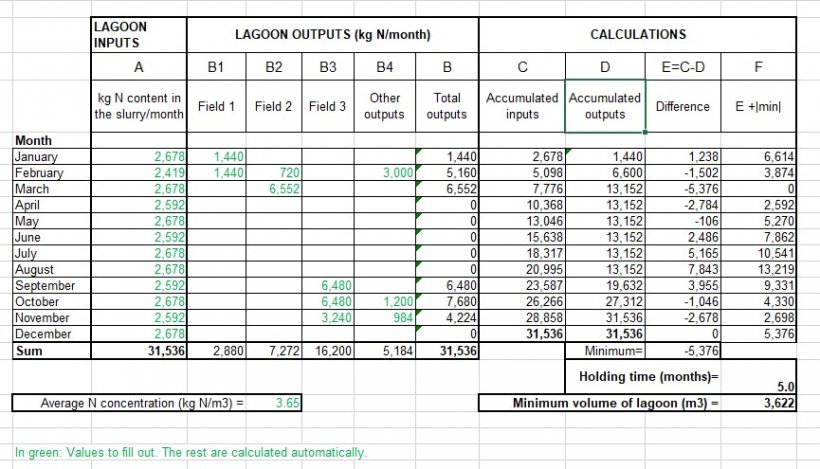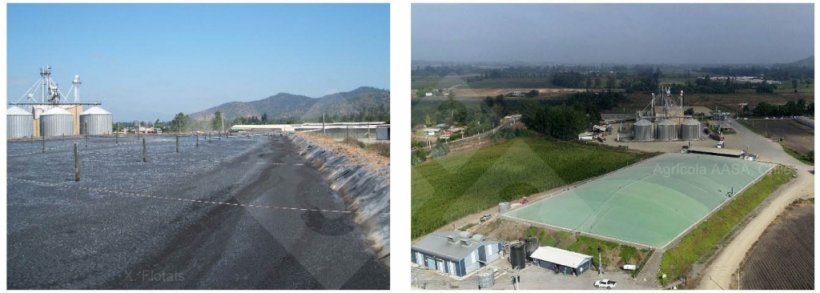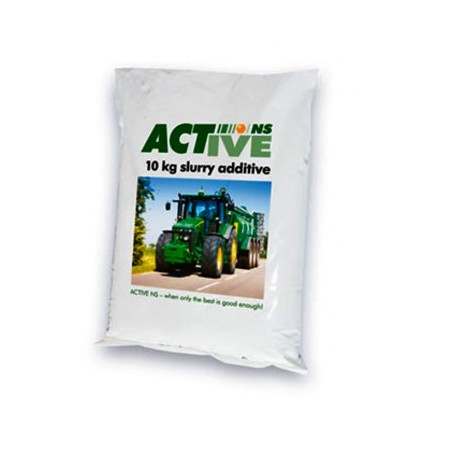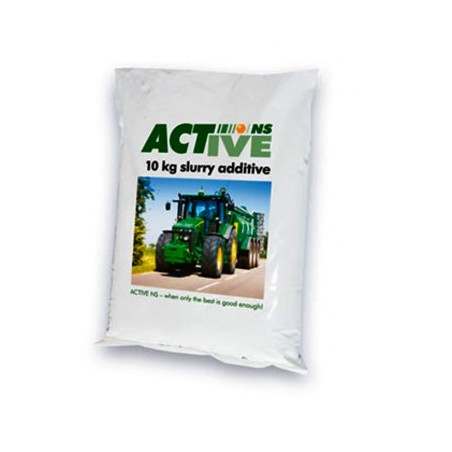Minimum storage time
To calculate the minimum storage time or the minimum capacity needed, the fertilization plan must be available, namely, the planning of the application rates and the time of the year when the slurry will be taken out of the lagoon. If nitrogen is used as a criterion for fertilization planning, it will be useful to determine the minimum storage capacity using nitrogen units. You can use a spreadsheet like the following to do this and modify the values to adapt it to your situation, as well as to simulate different options.


Here we explain how it works:
We assume a farm that produces 8,640 m3/year of slurry, with an average content of 3.65 kg N/m3 and a constant daily production. We fill in column A with the inputs to the lagoon with the monthly mass content of N (kg N/month) and column B with the outputs to fertilization, whether to our own fields or others' fields, with the monthly mass of N that leaves the lagoon. In the table, four different types of output (B1, ..., B4) have been assumed, with column B being the sum of the four. The total sum of N generated during the year (inputs) must coincide with the total sum of the outputs (31,536 kg N/year in this example). If the outputs are lower, there would be a surplus situation, in which the surplus must also leave the system, either through biological elimination of N or through nitrogen recovery and export; in any case, these will also be outputs and they should be added to column B4 in the month in which they occur. In the example, it has been assumed that these outputs are produced to fertilize other people's fields in the months they are produced. It would also be possible to assume that the total surplus nitrogen (5,184 kg N/year, column B4) is distributed evenly each month (432 kg N/month) in the form of a transfer to an authorized agent.
Other aspects to keep in mind in regards to sizing
Preventing rainwater from accumulating in the lagoon, avoiding water losses from drinkers, and minimizing the water used for cleaning have a positive effect on minimizing the volume of slurry storage and the cost to transport it. Swine industry regulations and action plans in areas vulnerable to nitrate contamination indicate the minimum retention times that must be complied, with a higher value needed if it is calculated according to the specific seasonal needs of fertilization, as in the previous example.
Not to be forgotten is ensuring the lagoons are waterproof; periodic cleaning to prevent the accumulation of sand, which reduces the useful capacity; as well as the recommendation to cover the lagoon to prevent the entry of rainwater and to minimize greenhouse gas emissions (GHG, mainly CH4) and NH3 resulting in a loss of fertilizer value.
During storage, some interesting processes occur, such as the reduction of pathogens and a certain degree of mineralization. On the other hand, uncontrolled fermentation and nitrogen losses due to the volatilization of ammonia and volatile organic compounds occur, generating bad odors and reducing fertilizer value. To avoid this, it is recommended that the lagoons be covered, that they be outside the building to prevent the animals from breathing the gases produced, which will have positive effects on production rates, and that the lagoon be outside the farm's sanitary area, to facilitate emptying without tractors and slurry tanks entering.

Slurry lagoon before and after being covered to prevent NH3 emissions and recover CH4 for energy use. Photos by the author (left) and by Agrícola AASA, Chile (right).
I have already sized my lagoon. Which scenario do I fit under, and what is the problem to be solved? 






